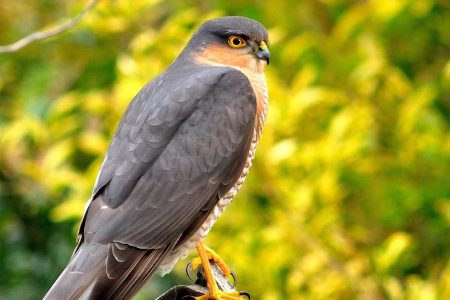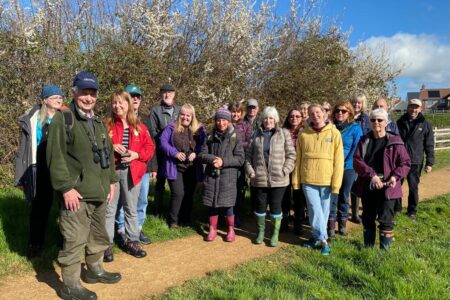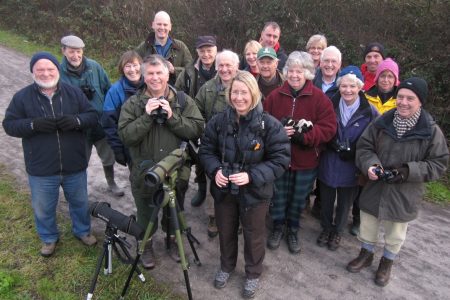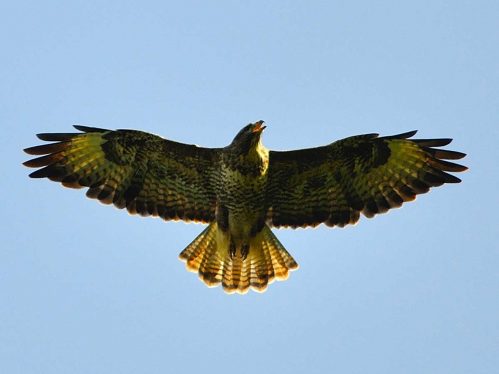
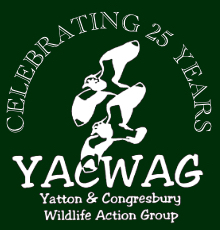
Wildlife
Birds
______
Around 200 species of birds are recorded in North Somerset every year. This large number is due to the diverse habitats, namely estuarine marshes, levels and moors, major reservoirs at Chew, Blagdon and Barrow Gurney, large blocks of deciduous and coniferous woodland and a small part of the Mendip Hills.
The YACWAG reserves and the surrounding countryside as well as local parks and residential gardens are excellent places to observe as well as encourage bird life to flourish.
Birds
YACWAG has erected around a hundred bird boxes on its Reserves, at Yatton and Congresbury schools and on other sites in the parishes. These boxes are cleaned each winter, repaired when necessary and a full record is maintained of the use (or not) of the boxes every year. There are long running and ongoing surveys of the Strawberry Line and Littlewood Reserves. YACWAG has recently taken responsibility for the North Somerset Levels Survey (another long term project) from the RSPB Weston super Mare Group.
When our Barn Owls nest we arrange evening watches (with a telescope) - these events have been very popular.
We are keen to hear about your local bird sightings, whether on a YACWAG reserve or not. Please email us and/or send us photographs and let us know if you are happy for them to go on the website.
Birds around Yatton and Congresbury
Herons are regular visitors to the local moors and most emanate from the long established heronry at Cleeve. In recent years they have been joined (mainly in winter) by Little Egrets and both species may be seen on or near to all of the YACWAG reserves. Cormorants visit the Yeo and larger rhynes and often perch on electricity pylons. In winter a few Teal congregate on the moors, numbers being higher during cold spells.
Several pairs of Sparrowhawks nest in the area and are most often reported from gardens with bird feeders. They hunt widely across our area and their young can be heard calling in late summer. Buzzards are now the most numerous bird of prey species in the UK and are often seen soaring over the villages as well as the adjacent countryside. Most years they nest in our Littlewood reserve but are surprisingly secretive when they are nesting. Not so Kestrels which generally nest in one of our owl boxes on Congresbury Moor; they are very vocal when they are setting up their territory. Peregrine Falcons visit in winter; on calm clear days look for them on or near the tops of electricity towers (pylons) which they use as lookouts or to eat their prey (generally) away from pestering Crows.
Moorhens are common once more in the waterways now that the introduced mink have declined and in winter Water Rails squeal from reed-lined rhynes. In cold winters parties of Lapwings can occasionally be seen but these now seem to gather in a few huge flocks perhaps as a defence against Peregrine Falcons. Snipe arrive from the north of the UK and Iceland; they feed at night and roost in YACWAG (and other wet) fields by day and are rarely seen unless flushed.
The area supports breeding Barn, Tawny and Little Owls but these species are generally nocturnal and in the case of Tawny and Little Owls more often heard than seen. YACWAG's management of its grassland reserves was the major driver of the recolonisation of the area by Barn Owls and at the end of the 2020 season no less than 63 Barn Owlets had fledged from boxes on YACWAG reserves, plus a further seven on a member’s land.
Green and Great Spotted Woodpeckers along with Kingfishers are some of our most colourful local birds and all can be seen (with luck and patience in the case of Kingfishers) whereas both Woodpeckers visit gardens, indeed 'Great Spots' are regular at many garden feeders. Cuckoos have declined dramatically in the last ten years and only Congresbury (around the golf course area) is a regular site for them now. Skylarks still nest in small numbers adjacent to but not on the YACWAG reserves and their lovely song is a welcome harbinger of Spring.
A few Swifts still nest in the two villages as do House Martins; there are more Swallows and many nest around the farms on the edges of Congresbury and Yatton. Other summer visitors are the warblers; Chiffchaffs and Blackcaps nest around the village and along the Strawberry Line Local Nature Reserve. The line also hosts the rare Cetti's Warbler (a warbler that remains with us in the winter), Reed and Sedge Warblers, as well as Common and Lesser Whitethroats, the latter visiting from their winter quarters in Ethiopia. Tiny Goldcrests are becoming town birds - they are in almost every large garden with an evergreen tree in Yatton.
Autumn brings insect-eating Stonechats and Meadow Pipits with Redwings and Fieldfares arriving from Scandinavia a few weeks later to join resident Blackbirds and Song Thrushes and feed on berry-laden shrubs and trees. Mistle Thrushes have become scarce but small post-breeding flocks appear in summer on Kenn Moor. In some winters Siskins fly in to feed on alder seeds - the alders in Littlewood and along the Moor Lane part of the Strawberry Line route being favoured. More recently Siskins have taken more readily to garden feeders. Nuthatches, Treecreepers and a few Marsh Tits are year-round residents on Cadbury Hill and Kings Wood and Treecreepers nest on the Littlewood reserve.
A few Linnets and Reed Buntings breed around rough grassland and reed-lined water courses, colourful Jays have become much more tolerant of humans as have Ravens, which now build large and obvious stick nests on local electricity pylons. Jackdaws are numerous and nest in any available chimney in the villages.
Bird Walks
YACWAG periodically runs bird walks, open to everyone. Led by our knowledgeable bird enthusiast Trevor Riddle, who also writes a monthly Bird News on this site, these popular walks are a long standing feature for YACWAG. Events such as these are emailed out to members and also posted on our calendar.
Further information
The Royal Society for the Protection of Birds promotes conservation and protection of birds and the wider environment throughout the UK. It's website is an excellent resource to learn more about the different bird species and help with identification.
© Copyright YACWAG, or original authors. All rights reserved. | Registered charity 1076362 | Privacy policy | Cookie policy | Terms & Conditions |Web design: StanfordGraphics

